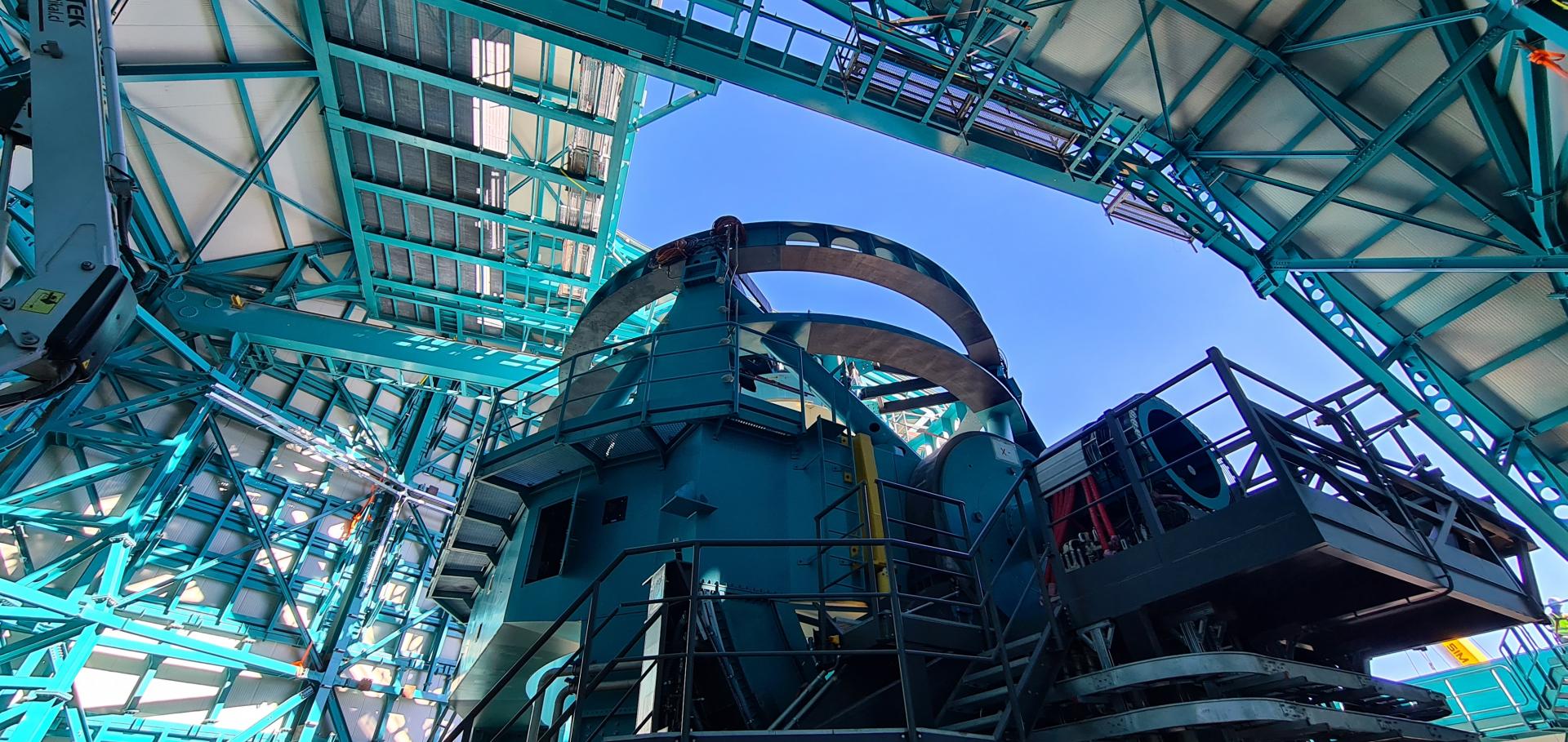Precision measurement of the X(3872) mass in J/psi pi(+) pi(-) decays.
Phys Rev Lett 103:15 (2009) 152001
Authors:
T Aaltonen, J Adelman, T Akimoto, B Alvarez González, S Amerio, D Amidei, A Anastassov, A Annovi, J Antos, G Apollinari, A Apresyan, T Arisawa, A Artikov, W Ashmanskas, A Attal, A Aurisano, F Azfar, W Badgett, A Barbaro-Galtieri, VE Barnes, BA Barnett, P Barria, P Bartos, V Bartsch, G Bauer, P-H Beauchemin, F Bedeschi, D Beecher, S Behari, G Bellettini, J Bellinger, D Benjamin, A Beretvas, J Beringer, A Bhatti, M Binkley, D Bisello, I Bizjak, RE Blair, C Blocker, B Blumenfeld, A Bocci, A Bodek, V Boisvert, G Bolla, D Bortoletto, J Boudreau, A Boveia, B Brau, A Bridgeman, L Brigliadori, C Bromberg, E Brubaker, J Budagov, HS Budd, S Budd, S Burke, K Burkett, G Busetto, P Bussey, A Buzatu, KL Byrum, S Cabrera, C Calancha, M Campanelli, M Campbell, F Canelli, A Canepa, B Carls, D Carlsmith, R Carosi, S Carrillo, S Carron, B Casal, M Casarsa, A Castro, P Catastini, D Cauz, V Cavaliere, M Cavalli-Sforza, A Cerri, L Cerrito, SH Chang, YC Chen, M Chertok, G Chiarelli, G Chlachidze, F Chlebana, K Cho, D Chokheli, JP Chou, G Choudalakis, SH Chuang, K Chung, WH Chung, YS Chung, T Chwalek, CI Ciobanu, MA Ciocci, A Clark, D Clark, G Compostella, ME Convery, J Conway, M Cordelli, G Cortiana, CA Cox, DJ Cox, F Crescioli, C Cuenca Almenar, J Cuevas, R Culbertson, JC Cully, D Dagenhart, M Datta, T Davies, P de Barbaro, S De Cecco, A Deisher, G De Lorenzo, M Dell'Orso, C Deluca, L Demortier, J Deng, M Deninno, PF Derwent, A Di Canto, GP di Giovanni, C Dionisi, B Di Ruzza, JR Dittmann, M D'Onofrio, S Donati, P Dong, J Donini, T Dorigo, S Dube, J Efron, A Elagin, R Erbacher, D Errede, S Errede, R Eusebi, HC Fang, S Farrington, WT Fedorko, RG Feild, M Feindt, JP Fernandez, C Ferrazza, R Field, G Flanagan, R Forrest, MJ Frank, M Franklin, JC Freeman, I Furic, M Gallinaro, J Galyardt, F Garberson, JE Garcia, AF Garfinkel, P Garosi, K Genser, H Gerberich, D Gerdes, A Gessler, S Giagu, V Giakoumopoulou, P Giannetti, K Gibson, JL Gimmell, CM Ginsburg, N Giokaris, M Giordani, P Giromini, M Giunta, G Giurgiu, V Glagolev, D Glenzinski, M Gold, N Goldschmidt, A Golossanov, G Gomez, G Gomez-Ceballos, M Goncharov, O González, I Gorelov, AT Goshaw, K Goulianos, A Gresele, S Grinstein, C Grosso-Pilcher, RC Group, U Grundler, J Guimaraes da Costa, Z Gunay-Unalan, C Haber, K Hahn, SR Hahn, E Halkiadakis, B-Y Han, JY Han, F Happacher, K Hara, D Hare, M Hare, S Harper, RF Harr, RM Harris, M Hartz, K Hatakeyama, C Hays, M Heck, A Heijboer, J Heinrich, C Henderson, M Herndon, J Heuser, S Hewamanage, D Hidas, CS Hill, D Hirschbuehl, A Hocker, S Hou, M Houlden, S-C Hsu, BT Huffman, RE Hughes, U Husemann, M Hussein, J Huston, J Incandela, G Introzzi, M Iori, A Ivanov, E James, D Jang, B Jayatilaka, EJ Jeon, MK Jha, S Jindariani, W Johnson, M Jones, KK Joo, SY Jun, JE Jung, TR Junk, T Kamon, D Kar, PE Karchin, Y Kato, R Kephart, W Ketchum, J Keung, V Khotilovich, B Kilminster, DH Kim, HS Kim, HW Kim, JE Kim, MJ Kim, SB Kim, SH Kim, YK Kim, N Kimura, L Kirsch, S Klimenko, B Knuteson, BR Ko, K Kondo, DJ Kong, J Konigsberg, A Korytov, AV Kotwal, M Kreps, J Kroll, D Krop, N Krumnack, M Kruse, V Krutelyov, T Kubo, T Kuhr, NP Kulkarni, M Kurata, S Kwang, AT Laasanen, S Lami, S Lammel, M Lancaster, RL Lander, K Lannon, A Lath, G Latino, I Lazzizzera, T LeCompte, E Lee, HS Lee, SW Lee, S Leone, JD Lewis, C-S Lin, J Linacre, M Lindgren, E Lipeles, A Lister, DO Litvintsev, C Liu, T Liu, NS Lockyer, A Loginov, M Loreti, L Lovas, D Lucchesi, C Luci, J Lueck, P Lujan, P Lukens, G Lungu, L Lyons, J Lys, R Lysak, D MacQueen, R Madrak, K Maeshima, K Makhoul, T Maki, P Maksimovic, S Malde, S Malik, G Manca, A Manousakis-Katsikakis, F Margaroli, C Marino, CP Marino, A Martin, V Martin, M Martínez, R Martínez-Ballarín, T Maruyama, P Mastrandrea, T Masubuchi, M Mathis, ME Mattson, P Mazzanti, KS McFarland, P McIntyre, R McNulty, A Mehta, P Mehtala, A Menzione, P Merkel, C Mesropian, T Miao, N Miladinovic, R Miller, C Mills, M Milnik, A Mitra, G Mitselmakher, H Miyake, N Moggi, MN Mondragon, CS Moon, R Moore, MJ Morello, J Morlock, P Movilla Fernandez, J Mülmenstädt, A Mukherjee, Th Muller, R Mumford, P Murat, M Mussini, J Nachtman, Y Nagai, A Nagano, J Naganoma, K Nakamura, I Nakano, A Napier, V Necula, J Nett, C Neu, MS Neubauer, S Neubauer, J Nielsen, L Nodulman, M Norman, O Norniella, E Nurse, L Oakes, SH Oh, YD Oh, I Oksuzian, T Okusawa, R Orava, K Osterberg, S Pagan Griso, C Pagliarone, E Palencia, V Papadimitriou, A Papaikonomou, AA Paramonov, B Parks, S Pashapour, J Patrick, G Pauletta, M Paulini, C Paus, T Peiffer, DE Pellett, A Penzo, TJ Phillips, G Piacentino, E Pianori, L Pinera, K Pitts, C Plager, L Pondrom, O Poukhov, N Pounder, F Prakoshyn, A Pronko, J Proudfoot, F Ptohos, E Pueschel, G Punzi, J Pursley, J Rademacker, A Rahaman, V Ramakrishnan, N Ranjan, I Redondo, P Renton, M Renz, M Rescigno, S Richter, F Rimondi, L Ristori, A Robson, T Rodrigo, T Rodriguez, E Rogers, S Rolli, R Roser, M Rossi, R Rossin, P Roy, A Ruiz, J Russ, V Rusu, B Rutherford, H Saarikko, A Safonov, WK Sakumoto, O Saltó, L Santi, S Sarkar, L Sartori, K Sato, A Savoy-Navarro, P Schlabach, A Schmidt, EE Schmidt, MA Schmidt, MP Schmidt, M Schmitt, T Schwarz, L Scodellaro, A Scribano, F Scuri, A Sedov, S Seidel, Y Seiya, A Semenov, L Sexton-Kennedy, F Sforza, A Sfyrla, SZ Shalhout, T Shears, PF Shepard, M Shimojima, S Shiraishi, M Shochet, Y Shon, I Shreyber, P Sinervo, A Sisakyan, AJ Slaughter, J Slaunwhite, K Sliwa, JR Smith, FD Snider, R Snihur, A Soha, S Somalwar, V Sorin, T Spreitzer, P Squillacioti, M Stanitzki, R St Denis, B Stelzer, O Stelzer-Chilton, D Stentz, J Strologas, GL Strycker, JS Suh, A Sukhanov, I Suslov, T Suzuki, A Taffard, R Takashima, Y Takeuchi, R Tanaka, M Tecchio, PK Teng, K Terashi, J Thom, AS Thompson, GA Thompson, E Thomson, P Tipton, P Ttito-Guzmán, S Tkaczyk, D Toback, S Tokar, K Tollefson, T Tomura, D Tonelli, S Torre, D Torretta, P Totaro, S Tourneur, M Trovato, S-Y Tsai, Y Tu, N Turini, F Ukegawa, S Vallecorsa, N van Remortel, A Varganov, E Vataga, F Vázquez, G Velev, C Vellidis, M Vidal, R Vidal, I Vila, R Vilar, T Vine, M Vogel, I Volobouev, G Volpi, P Wagner, RG Wagner, RL Wagner, W Wagner, J Wagner-Kuhr, T Wakisaka, R Wallny, SM Wang, A Warburton, D Waters, M Weinberger, J Weinelt, WC Wester, B Whitehouse, D Whiteson, AB Wicklund, E Wicklund, S Wilbur, G Williams, HH Williams, P Wilson, BL Winer, P Wittich, S Wolbers, C Wolfe, T Wright, X Wu, F Würthwein, S Xie, A Yagil, K Yamamoto, J Yamaoka, UK Yang, YC Yang, WM Yao, GP Yeh, K Yi, J Yoh, K Yorita, T Yoshida, GB Yu, I Yu, SS Yu, JC Yun, L Zanello, A Zanetti, X Zhang, Y Zheng, S Zucchelli, CDF Collaboration
Abstract:
We present an analysis of the mass of the X(3872) reconstructed via its decay to J/psi pi(+)pi(-) using 2.4 fb(-1) of integrated luminosity from pp collisions at square root(s)=1.96 TeV, collected with the CDF II detector at the Fermilab Tevatron. The possible existence of two nearby mass states is investigated. Within the limits of our experimental resolution the data are consistent with a single state, and having no evidence for two states we set upper limits on the mass difference between two hypothetical states for different assumed ratios of contributions to the observed peak. For equal contributions, the 95% confidence level upper limit on the mass difference is 3.6 MeV/c(2). Under the single-state model the X(3872) mass is measured to be 3871.61+/-0.16(stat)+/-0.19(syst) MeV/c(2), which is the most precise determination to date.


